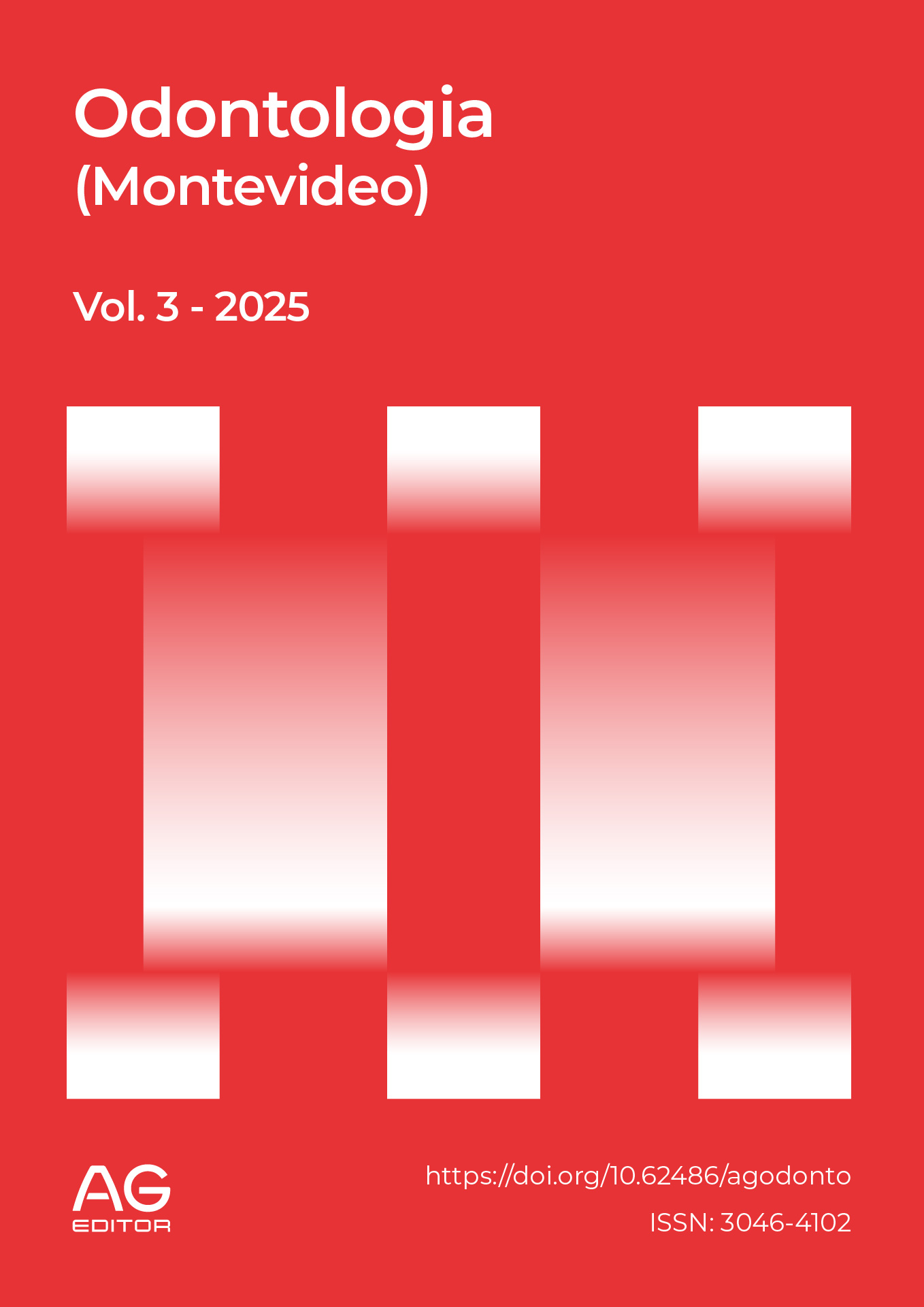Tooth whitening: esthetic benefits and clinical challenges
DOI:
https://doi.org/10.62486/agodonto2025195Keywords:
Tooth whitening, hydrogen peroxide, tooth enamel, Candida albicans, oral microbiotaAbstract
Introduction: Tooth whitening has been widely used as an esthetic procedure, growing in demand since its initial description in 1864. This process uses chemical agents such as hydrogen peroxide, capable of oxidizing chromogens present in tooth enamel, lightening the teeth. However, its continued use can have side effects, including demineralization of the enamel and alterations in the oral microbiota, such as the growth of Candida albicans.
Development: Several studies have analyzed the effects of hydrogen peroxide at different concentrations. At high concentrations, such as 35%, its capacity to alter the morphology and mineral content of dental enamel, increasing its roughness and favoring the adhesion of microorganisms has been demonstrated. The formation of biofilms by bacteria and fungi, such as Streptococcus mutans and Candida albicans, has been the subject of debate, with contradictory results regarding their prevalence on surfaces treated with bleaching agents. This study found that the control group, without peroxide treatment, presented greater adhesion of C. albicans, which could be attributed to an antimicrobial effect of the oxidizing agent.
Conclusion: Tooth whitening, although effective as an esthetic procedure, presents clinical challenges due to its potential adverse effects. The findings highlight the need for further research to fully understand the impact of these agents on the oral microbiota and enamel. Future studies should include larger samples and employ advanced techniques to improve the validity of the results and optimize the safety of the procedures.
References
Mancera CAG, Cornejo PMA, Méndez MR, et al. Efecto del blanqueamiento con peróxido de hidrógeno al 38% sobre la microestructura del esmalte dental. Oral. 2011;12(36):687-90.
Dahl J, Pallesen U. Tooth bleaching- A critical review of the biological aspects. Crit Rev Oral Biol Med. 2003;14(4):292-304.
Vargas-Koudriavtsev T, Durán-Sedó R, Sáenz-Bonilla P, et al. Efecto de agentes de blanqueamiento dental sobre la concentración de fosfato en el esmalte dental por medio de espectroscopia Raman. Rev Odont Mex. 2015;19(4):232-9.
Fu B, Hot-Hanning W, Hanning M. Effects of dental bleaching on micro- and nano-morphological alterations of the enamel surface. Am J Dent. 2007;20(1):35-40.
Zanolla J, Marques A, da Costa DC, de Souza AS, Coutinho M. Influence of tooth bleaching on dental enamel microhardness: a systematic review and meta-analysis. Aust Dent J. 2017;62(3):276-82.
Wasserman Milhen I, Cardona Silva AM, Fernandez Correa DM, Mejia Ayala JA. Efectividad y estabilidad del blanqueamiento dental, una revisión sistemática. Rev Salud Bosque. 2015;4(2):7-18.
Tezel H, Özata F. Effect of bleaching agents on calcium loss from the enamel surface. Quintessence. 2007;38(4):339-47.
Zeczkowski M. Effect of different storage conditions on the physical properties of bleached enamel: An in vitro. Elsevier. 2015:1154-61.
Hegedüs C, Bistey T, Flóra-Nagy K, Keszthelyi G, Jenei A. An atomic force microscopy study on the effect of bleaching agents on enamel surface. J Dent. 1999;27:509-15.
Sudbery P, Gow N, Berman J. The distinct morphogenic states of Candida albicans. Trends Microbiol. 2004;12(7):317-24.
Barrancos PJ. Operatoria dental. Avances clínicos, restauraciones y estética. 5th ed. Buenos Aires: Panamericana; 2015. Capítulo 34, p. 975.
Mata de Henning M, Perrone M. La prótesis odontológica en la ecología de Candida albicans en cavidad bucal. Acta Odontol Venez. 2001;39(3):18-24.
Di Cosola M, Cazzolla AP, Charitos IA, Ballini A, Inchingolo F, Santacroce L. Candida albicans and oral carcinogenesis: a brief review. J Fungi. 2021;7(6):476.
Hwang G, Marsh G, Gao L, Waugh R, Koo H. Binding force dynamics of Streptococcus mutans-glucosyltransferase B to Candida albicans. J Dent Res. 2015;94(9):310-7.
Montelongo-Jauregui D, Lopez-Ribot J. Candida interactions with the oral bacterial microbiota. J Fungi. 2018;4(4):122.
Cardozo-Germán EI, Pardi G. Algunas consideraciones sobre Candida albicans como agente etiológico de candidiasis bucal. Acta Odontol Venez. 2002;40(1):9-17.
Petkova Gueorguieva de Rodríguez M. Efectos clínicos y estructurales del blanqueamiento dental. Odon Sanmarquina. 2005;8(2):34-6.
Shamel M, Al-Ankily MM, Bakr MM. Influence of different types of whitening toothpastes on the tooth color, enamel surface roughness, and enamel morphology of human teeth. F1000Res. 2019;8:1764.
Monterubbianesi R, Tosco V, Bellezze T, Giuliani G, Özcan M, Putignano A, Orsini G. A comparative evaluation of nanohydroxyapatite-enriched hydrogen peroxide home bleaching system on color, hardness, and microstructure of dental enamel. Materials Basel. 2021;14(3072).
Goldstein RE, Lancaster J. Survey of patient attitudes toward current esthetic procedures. J Prosthet Dent. 1984;2:775.
Alkahtani R, Stone S, German M, Waterhouse P. A review on dental whitening. J Dent. 2020;100:103423.
Pardi G. Determinantes de patogenicidad de Candida albicans. Acta Odontol Venez. 2002;40(2):185-92.
Panizo MM, Reviákina V. Candida albicans y su efecto patógeno sobre las mucosas. Rev Soc Ven Microbiol. 2001;21(2):38-45.
Joiner A. The bleaching of teeth: a review of the literature. J Dent. 2006;34:412-9.
Siciliano A, Santos S, Quezada R, Escobar W, Aguirre G, Aguirre K, et al. Bio-banco de órganos dentales de la Facultad de Odontología, Universidad de El Salvador. Rev Minerva. 2022;5:91-103.
Gonzáles Pita LC, Úsuga Vacca MV, Torres Rodríguez C, Delgado Mejía E. Biobanco de dientes humanos para investigación en odontología. Acta Odontol Colomb. 2014;4:9-21.
Medina S, Mejía C, Moreno F. Comportamiento in vitro del colágeno de la unión amelodentinaria en premolares humanos sometidos a altas temperaturas. Salutem Scientia. 2015;15:44-8.
Rubio L, Sioli JM, Santos I, Fonseca GM, Martin-de-las-Heras S. Alteraciones morfológicas en dientes sometidos a altas temperaturas con interés forense. Int J Morphol. 2016;34:719-28.
Hosoya N, Honda K, Iino F, Arai T. Changes in enamel surface roughness and adhesion of Streptococcus mutans to enamel after vital bleaching. J Dent. 2003;31:543-8.
Anggausuma K, Ptatiwi D, Widyarman A. The effect of carbamide peroxide on surface enamel structural changes and Streptococcus mutans attachment. Sci Dent J. 2020;4:6-10.
Al-Jubori SH, Al-Sabawi T, Taha MY. Study of the adherence of Streptococcus mutans on bleached and fluoridated tooth surfaces (an in vitro study). Al-Rafidain Dent J. 2013;13:116-21.
Romero AJM, Romero AC. Adherencia del Streptococcus mutans en dientes permanentes humanos sometidos a dos agentes blanqueadores. Kiru. 2009;6:39-45.
Briso A, Silva U, Souza M, Rahal V, Júnioe E, Cintra L. A clinical randomized study on the influence of dental whitening on Streptococcus mutans population. Aust Dent J. 2017;0:1-5.
Attia R, Kamel M. Changes in surface roughness of bleached enamel by using different remineralizing agents. Tanta Dent J. 2016;13:179-86.
Zheng C, Pan J, Wang Z, Wang Y. Effects of hydrogen peroxide-containing bleaching on the growth of Streptococcus mutans biofilm on enamel disc surface. J Peking Univ Health Sci. 2014;46:30-4.
Ittatirut S, Matangkasombut O, Thanyasrisung P. In-office bleaching gel with 35% hydrogen peroxide enhanced biofilm formation of early colonizing streptococci on human enamel. J Dent. 2014;42:1480-6.
Viana de Sousa T, Jordão CC, Abreu-Pereira CA, Pereira AL, Barbugli PA, Klein MI, et al. El peróxido de hidrógeno mejora la eficacia de la terapia fotodinámica contra las biopelículas de Candida albicans. Biofouling. 2023;39:94-109.
Brosh T, Strouthou S, Sarne O. Efectos de las superficies bucales y linguales, procedimientos de acondicionamiento del esmalte y duración del almacenamiento en las características de desprendimiento de los brackets. J Dent. 2004;33:99-105.
Napimoga MH, de Oliveira R, Reis AF, Gonçalves RB, Giannini M. In vitro antimicrobial activity of peroxide-based bleaching agents. Quintessence Int. 2007;38:329-33.
Oliveira DP, Gomes BP, Zaia AA, Souza-Filho FJ, Ferraz CC. In vitro assessment of a gel base containing 2% chlorhexidine as a sodium perborate's vehicle for intracoronal bleaching of discolored teeth. J Endod. 2006;32:672-4.
Franz-Montan M, Ramacciato JC, Rodrigues JA, Marchi GM, Rosalen PL, Groppo FC. The effect of combined bleaching techniques on oral microbiota. Indian J Dent Res. 2009;20:304-7.
Philippe Ahariz M, Courtois P. Candida albicans susceptibility to lactoperoxidase-generated hypoiodite. Clin Cosmet Investig Dent. 2010;2:69-78.
Alkmin YT, Sartorelli R, Flório FM, Basting RT. Comparative study of the effects of two bleaching agents on oral microbiota. Oper Dent. 2005;30:417-23.
Li Y, Du J, Huang S, Wang S, Wang Y, Cai Z, et al. Hydrogen peroxide potentiates antimicrobial photodynamic therapy in eliminating Candida albicans and Streptococcus mutans dual-species biofilm from denture base. Photodiagnosis Photodyn Ther. 2022;37:10-6.
Abdelshafy AM, Neetoo H, Al-Asmari F. Antimicrobial activity of hydrogen peroxide for application in food safety and COVID-19 mitigation: an updated review. J Food Prot. 2024;87:87-9.
Ferguson JW, et al. Effectiveness of intracanal irrigants and medications against the yeast Candida albicans. J Endod. 2002;28(2):68-71.
Soto AF, Mendes EM, Arthur RA, Negrini TC, Lamers ML, Mengatto CM. Antimicrobial effect and cytotoxic activity of vinegar-hydrogen peroxide mixture: A possible alternative for denture disinfection. J Prosthet Dent. 2019;121.
Teixeira EF, Girundi ALG, Alexandrino LD, Morel LL, Almeida MVR, Dos Santos VR, et al. Effects of disinfection with a vinegar-hydrogen peroxide mixture on the surface characteristics of denture acrylic resins. Clin Oral Investig. 2023;28:45.
Kunz D, Wirth J, Sculean A, Eick S. In vitro activity of additive application of hydrogen peroxide in antimicrobial photodynamic therapy using LED in the blue spectrum against bacteria and biofilm associated with periodontal disease. Photodiagnosis Photodyn Ther. 2019;26:306-12.
Huahua T, Rudy J, Kunin CM. Effect of hydrogen peroxide on growth of Candida, Cryptococcus, and other yeasts in simulated blood culture bottles. J Clin Microbiol. 1991;29(2):328-32.
Kunz D, Wirth J, Sculean A, Eick S. In-vitro activity of additive application of hydrogen peroxide in antimicrobial photodynamic therapy using LED in the blue spectrum against bacteria and biofilm associated with periodontal disease. Photodiagnosis Photodyn Ther. 2019; 26:306-12.
Huahua T, Rudy J, Kunin CM. Effect of hydrogen peroxide on growth of Candida, Cryptococcus, and other yeasts in simulated blood culture bottles. J Clin Microbiol. 1991;29(2):328-32.
Jaña PD, Yévenes LI, Rivera AS. Estudio clínico comparativo entre colutorio de p-clorofenol y peróxido de hidrógeno con colutorio de clorhexidina al 0.12% en el crecimiento de placa microbiana y gingivitis. Rev Clin Periodoncia Implantol Rehabil Oral. 2010;3(2):65-8.
Oliveira DP, Gomez BP, Zaia AA. Actividad antimicrobiana ex vivo de varios agentes blanqueadores. Rev Endodoncia. 2008; 41:1054-8.
.
Published
Issue
Section
License
Copyright (c) 2025 Laura Marina Kees , Virginia Jewtuchowicz , María Laura Garzon (Author)

This work is licensed under a Creative Commons Attribution 4.0 International License.
The article is distributed under the Creative Commons Attribution 4.0 License. Unless otherwise stated, associated published material is distributed under the same licence.





